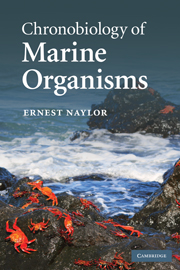Book contents
- Frontmatter
- Contents
- Preface
- 1 Moonshine
- 2 Biorhythms of coastal organisms
- 3 Tidal and daily time-cues
- 4 Clocks and compasses
- 5 Lunar and semilunar biorhythms
- 6 Annual biorhythms
- 7 Plankton vertical migration rhythms
- 8 Staying put in estuaries
- 9 Ocean drifters
- 10 Living clockwork
- References
- Author index
- Subject index
- Plate section
1 - Moonshine
Published online by Cambridge University Press: 05 June 2012
- Frontmatter
- Contents
- Preface
- 1 Moonshine
- 2 Biorhythms of coastal organisms
- 3 Tidal and daily time-cues
- 4 Clocks and compasses
- 5 Lunar and semilunar biorhythms
- 6 Annual biorhythms
- 7 Plankton vertical migration rhythms
- 8 Staying put in estuaries
- 9 Ocean drifters
- 10 Living clockwork
- References
- Author index
- Subject index
- Plate section
Summary
Beliefs…in an influence of the moon on life on Earth…are by no means all moonshine.
H. Munro Fox, 1928In 1957, Lamont C. Cole, a distinguished American ecologist, published an article entitled Biological clock in the unicorn (Cole, 1957). Surprisingly it appeared, not in a publication such as The Annals of Improbable Research, but in the prestigious scientific journal Science. It therefore had withstood critical scrutiny by peer review and was clearly of serious intent. In that journal, and with such a title, the article was guaranteed to make an impact, a precursor perhaps of scientific publications that in more recent years would compete for the Ig Nobel Prize for ‘science that makes you laugh and then makes you think’. The paper was published at a time when a group of his fellow American biologists headed by Frank A. Brown, Jr were describing daily rhythms of biological activity in a range of living things, from intact animals to slices of vegetables. From the running activity of rats on treadmills, to colour changes of fiddler crabs and oxygen uptake by slices of fresh potato, from locomotor activity rhythms in marine molluscs to oxygen consumption by marine algae, hourly values were shown to increase and decrease throughout the day in regular rhythmic patterns that persisted even in so-called constant conditions in the laboratory (Brown, 1954, 1958; Brown et al., 1955a, b).
- Type
- Chapter
- Information
- Chronobiology of Marine Organisms , pp. 1 - 15Publisher: Cambridge University PressPrint publication year: 2010
- 1
- Cited by



